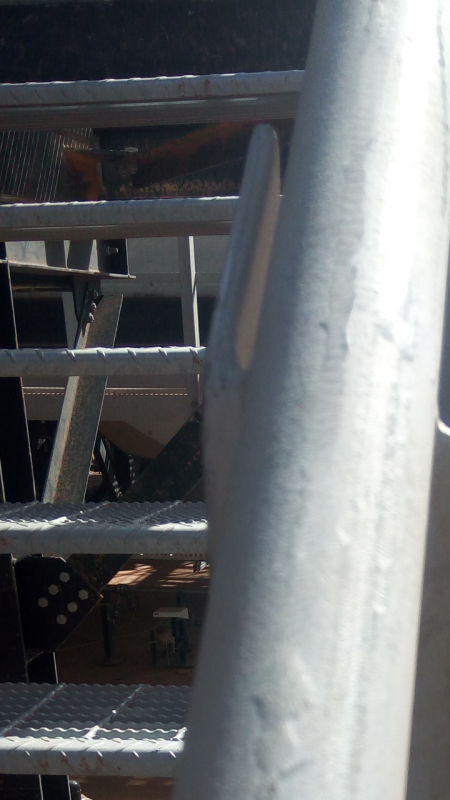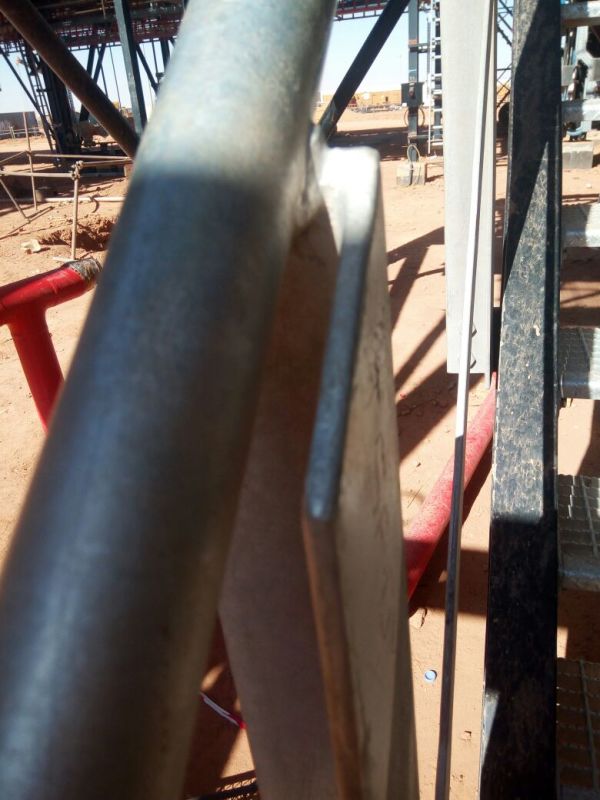Navigation
Install the app
How to install the app on iOS
Follow along with the video below to see how to install our site as a web app on your home screen.
Note: This feature may not be available in some browsers.
More options
Style variation
-
Congratulations cowski on being selected by the Eng-Tips community for having the most helpful posts in the forums last week. Way to Go!
You are using an out of date browser. It may not display this or other websites correctly.
You should upgrade or use an alternative browser.
You should upgrade or use an alternative browser.
Sharp edge of handrail 2
- Thread starter jasem81
- Start date
- Status
- Not open for further replies.
TehMightyEngineer
Structural
Grinder? A thick epoxy coating of some sort? Gloves?
Professional Engineer (ME, NH, MA) Structural Engineer (IL)
American Concrete Industries
Professional Engineer (ME, NH, MA) Structural Engineer (IL)
American Concrete Industries
I can't tell from the photo, but, is it the roughness of the galvanising? Gloves are not a solution. The surface may be carefully ground off, but, may cause a greater problem. How corrosive is the environment? A high build zinc rich epoxy patch smoothing out the roughness in conjunction with local grinding may work. This may cause cosmetic problems; it will not oxidize like normal HDG. You should review your 'dipping' procedure. We used to give the object a sharp smack with a hammer when it emerged from the tank (I worked in a galvanising shop for a couple of summers while going to university). This tended to leave a smooth surface.
Dik
Dik
As JLNJ notes, the coating should be compatible with zinc. Many coatings in particular oil based, form a zinc saponification that over a short period of time causes the bond to fail. Check with your coating supplier to get a coating that works.
Dik
Dik
jimstructures
Structural
Could the Original Poster mark up the attached photograph with arrows pointing at the mystery sharp edge???
Jim
Jim
- Thread starter
- #8
- Thread starter
- #10
Tmoose,
You are right, the problem that Client is not accepting the current status and he is considering this shape is not meeting the HSE requirements, we have huge quantity which is already erected, we need to find a solution away from cutting and welding
You are right, the problem that Client is not accepting the current status and he is considering this shape is not meeting the HSE requirements, we have huge quantity which is already erected, we need to find a solution away from cutting and welding
A couple of coating systems:
SYSTEM 10: EPOXY COATING OVER HDG
BASE METAL -HDG STEEL
CLEANING -TO SSPC-SP 1
WASH -POLYCLUTCH 97-687 BY PPG
PRIMER -AMERLOCK 400 TWO COMPONENT EPOXY BY PPG
TOPCOAT -AMERCOAT 450H TWO COMPONENT ALIPHATIC POLYURETHANE TOPCOAT BY PPG
SYSTEM 11: EPOXY COATING OVER HDG (ALTERNATIVE)
BASE METAL -HDG STEEL
CLEANING -TO SSPC-SP 1
PRIMER -DEVOE DEVRAN 201 EPOXY
TOPCOAT -DEVOE DEVTHANE 379 URETHANE
The topcoat can be safety yellow... What HSE requirements and why is it not conforming?
Dik
SYSTEM 10: EPOXY COATING OVER HDG
BASE METAL -HDG STEEL
CLEANING -TO SSPC-SP 1
WASH -POLYCLUTCH 97-687 BY PPG
PRIMER -AMERLOCK 400 TWO COMPONENT EPOXY BY PPG
TOPCOAT -AMERCOAT 450H TWO COMPONENT ALIPHATIC POLYURETHANE TOPCOAT BY PPG
SYSTEM 11: EPOXY COATING OVER HDG (ALTERNATIVE)
BASE METAL -HDG STEEL
CLEANING -TO SSPC-SP 1
PRIMER -DEVOE DEVRAN 201 EPOXY
TOPCOAT -DEVOE DEVTHANE 379 URETHANE
The topcoat can be safety yellow... What HSE requirements and why is it not conforming?
Dik
Jasem81:
You’re not doing a very good job of explaining to us or showing in your photos, exactly what the various problems are. You should get with your customer and actually list the various types of roughness and sharp spots, and approx. quantities, etc., so you have an idea of what tools will be used most and are most important. The customer has every right to be concerned about these problems on handrails and the like, when his workers are going to cut their hands when using the handrails.
It looks like you have one size of pipe handrail, and then maybe several different roughness problems on them. I would be looking for some tools and light machines which semi-skilled workers could use on every handrail assembly on the project to clean these rough and sharp spots up. The single size pipe should simplify you tooling needs. Auto body shops have some shaping and finishing tools for non-flat surfaces which might work for some of the problems. Maybe some woodworking or light machine shop tools like belt sanders, flap sanding wheels, angle grinders, various other grinders, routers, etc. might work. The trick is to mount these to shaped bases, matching the pipe dia. so the workers can’t do more damage than they do good. Maybe a special shaped cutter/grinder and tool base will slide along, right on the pipe shape, and just clean up the high spots. This all takes some imagination and engineering judgement on your end. Certainly, I would involve your other subs who played a part in this mess.
You’re not doing a very good job of explaining to us or showing in your photos, exactly what the various problems are. You should get with your customer and actually list the various types of roughness and sharp spots, and approx. quantities, etc., so you have an idea of what tools will be used most and are most important. The customer has every right to be concerned about these problems on handrails and the like, when his workers are going to cut their hands when using the handrails.
It looks like you have one size of pipe handrail, and then maybe several different roughness problems on them. I would be looking for some tools and light machines which semi-skilled workers could use on every handrail assembly on the project to clean these rough and sharp spots up. The single size pipe should simplify you tooling needs. Auto body shops have some shaping and finishing tools for non-flat surfaces which might work for some of the problems. Maybe some woodworking or light machine shop tools like belt sanders, flap sanding wheels, angle grinders, various other grinders, routers, etc. might work. The trick is to mount these to shaped bases, matching the pipe dia. so the workers can’t do more damage than they do good. Maybe a special shaped cutter/grinder and tool base will slide along, right on the pipe shape, and just clean up the high spots. This all takes some imagination and engineering judgement on your end. Certainly, I would involve your other subs who played a part in this mess.
it looks to me as though the issue is the support structure near the hand rail. the hand rail is welded to what looks like an angle section which is close to the hand rail, interfering (maybe?) with someone grabbing at the hand rail. doesn't look particularly sharp (looks rounded), I guess the upright supporting the hand rail is an angle, with a flange welded to the stairs ?
did the client accept the drawings before assembly ? (I'm guessing not)
I'm guessing that maybe the hand rail should have been welded to the offending flange ?
another day in paradise, or is paradise one day closer ?
did the client accept the drawings before assembly ? (I'm guessing not)
I'm guessing that maybe the hand rail should have been welded to the offending flange ?
another day in paradise, or is paradise one day closer ?
TehMightyEngineer
Structural
rb1957 has it I think. I thought OP was talking about roughness of the rail itself but his 2nd picture seems to show the supporting angle as being the issue. Completely different problem, please explain this better next time OP.
We always use pipes the same size as the rail to avoid this issue. Just want to be clear; is this a handrail or a guardrail (fall protection). There's a big difference.
Professional Engineer (ME, NH, MA) Structural Engineer (IL)
American Concrete Industries
We always use pipes the same size as the rail to avoid this issue. Just want to be clear; is this a handrail or a guardrail (fall protection). There's a big difference.
Professional Engineer (ME, NH, MA) Structural Engineer (IL)
American Concrete Industries
-
1
- #16
-
1
- #17
If the parallel edge of the angle is on the "inside to the stairs" side (instead of on the outside), I'd refuse it as well:
If someone were to fall of the stairs and bashed their heads on that edge, it could possibly cost them their life.
Reweld the angle so that the parallel edge is underneath the hand rail, and the perpendicular (to the handrail) side points outwards. Better still, choose pipe for the posts.
If someone were to fall of the stairs and bashed their heads on that edge, it could possibly cost them their life.
Reweld the angle so that the parallel edge is underneath the hand rail, and the perpendicular (to the handrail) side points outwards. Better still, choose pipe for the posts.
What building code are you following? The angle member shown in the second photograph does not appear to meet the requirements of IBC 2012 Section 1012 (Handrails), specifically with regard to clearance requirements around the handrail itself. Further, is this a guardrail or a handrail?
- Status
- Not open for further replies.
Similar threads
- Replies
- 6
- Views
- 1K
- Replies
- 4
- Views
- 2K
- Question
- Replies
- 0
- Views
- 3K
- Replies
- 6
- Views
- 898
- Replies
- 4
- Views
- 4K


